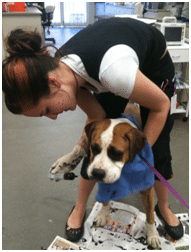Rat Bait Is Very Dangerous For Pets
Rat bait toxicity is the most common poisoning in dogs
Rat bait toxicity is one of the most common causes of pet poisonings. Most rat and mouse bait products are anti-coagulants; they function by causing uncontrolled bleeding. The products are designed to be tasty to encourage the rodents to eat them. This means they are also attractive to your pet. Even if you have bait in an inaccessible place for your pet, rodents can carry and drop the bait, allowing access to your pet.
Only a very small amount of bait (sometimes less than a gram) is required to cause toxicity. It can take between 2 and 5 days after eating the bait for symptoms to develop. At this stage your pet is at risk of bleeding to death
Symptoms
Lethargy, collapse
- Pale or white gum colour
- Bleeding from the nose or mouth, bleeding around the teeth
- Panting, coughing
- Distended abdomen
- Bruises in the mouth or on the skin.
- Swollen joints
If you suspect your pet has ingested a rodent poison, seek veterinary attention immediately as you can avoid problems if the toxin is removed.
What to expect at the vet
If ingestion has been in the last 12-24 hours:
- Medication to cause vomiting
- Charcoal solution to prevent further absorption of the toxin
- Advice to get a blood test taken approximately 2 to 3 days after toxin ingestion
If ingestion has been 2 – 5 days ago:
- Blood tests to assess clotting status of the blood and if your pet is bleeding, to assess extent of blood loss
- Vitamin K1 injections and oral tablets to help with the production of clotting proteins in the body
- Oxygen therapy if your pet has breathing problems
- IV fluids to support blood pressure
- Blood and plasma transfusions in severe cases
- In some cases when the lungs fill with blood, your pet may require mechanical ventilation to support their breathing
Most of the patients who are treated hours after ingestion do not go on to develop bleeding problems. In these cases a blood test will be recommended at a later date to confirm that they have not been affected by the toxin.
Those patients who are already showing signs of bleeding abnormalities can have successful recoveries if treated promptly – severe cases may require several days of hospitalisation for blood transfusions and supportive care. Unfortunately, if a pet is actively bleeding from this poison (internally or externally), they are unlikely to survive without appropriate care.
Bruising can be difficult to find below fur. Sometimes it can be seen more easily on the thinly haired abdoment. Your veterinarian may need to shave your pet’s fur to see this.

 Lethargy, collapse
Lethargy, collapse


